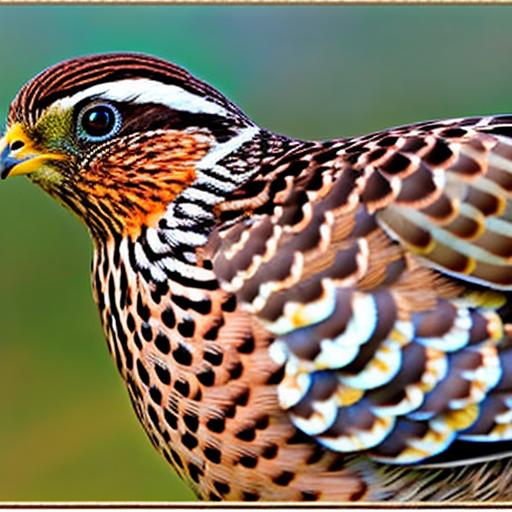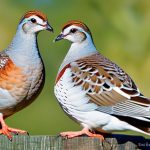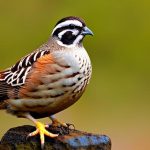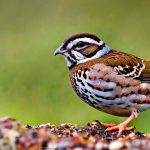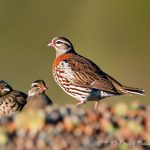Hawks are birds of prey known for their keen eyesight and swift hunting abilities. They are skilled hunters that primarily feed on small mammals, birds, and reptiles. Hawks are known to soar high in the sky, using their sharp vision to spot potential prey from great distances. Once they have located their target, they swoop down with incredible speed and accuracy to catch their prey. This hunting behavior can pose a threat to quail, which are ground-dwelling birds that are often targeted by hawks.
Quail, on the other hand, are small, plump birds that prefer to stay close to the ground. They are known for their distinctive call and are often found in grasslands, meadows, and agricultural fields. Quail are social birds that live in coveys and rely on dense vegetation for cover and protection from predators. Their ground-dwelling nature makes them vulnerable to aerial predators like hawks. Understanding the behavior of both hawks and quail is essential for creating a safe habitat for quail and implementing effective hawk deterrents.
Key Takeaways
- Hawks are natural predators of quail and their behavior should be understood to protect quail populations.
- Creating a safe habitat for quail involves providing suitable cover and food sources while minimizing hawk access.
- Implementing hawk deterrents such as visual deterrents and sound devices can help protect quail from hawk predation.
- Providing shelter and cover for quail through planting shrubs and grasses can help them evade hawk attacks.
- Monitoring and managing hawk activity is essential for understanding their impact on quail populations and taking necessary conservation measures.
- Working with local wildlife authorities can provide valuable guidance and support for hawk and quail conservation efforts.
- Educating others about the importance of hawk and quail conservation can help garner support and raise awareness for their protection.
Creating a Safe Habitat for Quail
Creating a safe habitat for quail involves providing the necessary resources for their survival, including food, water, shelter, and breeding sites. Quail thrive in areas with a mix of grasses, shrubs, and open spaces. They rely on dense vegetation for cover and protection from predators, including hawks. Landowners can create a safe habitat for quail by implementing habitat management practices such as prescribed burning, brush management, and creating brush piles. These practices help maintain the necessary vegetation structure that quail need for cover and nesting.
In addition to vegetation management, providing supplemental food and water sources can also benefit quail populations. Planting native grasses and forbs can provide food and cover for quail, while installing water sources such as birdbaths or small ponds can ensure they have access to water, especially during dry periods. By creating a safe habitat for quail, landowners can help mitigate the impact of hawk predation and support healthy quail populations.
Implementing Hawk Deterrents
Implementing hawk deterrents is an important aspect of managing hawk predation on quail populations. There are several non-lethal deterrent methods that can be used to discourage hawks from preying on quail. One effective method is the use of visual deterrents such as scarecrows, reflective tape, or predator balloons. These visual deterrents can disrupt the hunting behavior of hawks by creating a sense of unease or danger in the area.
Another non-lethal deterrent method is the use of sound deterrents such as distress calls or predator calls. These calls can mimic the sounds of distressed or predatory birds, which may deter hawks from hunting in the area. Additionally, providing physical barriers such as netting or wire mesh around quail habitats can help protect them from hawk predation. By implementing these non-lethal deterrent methods, landowners can help reduce the impact of hawk predation on quail populations while avoiding harm to the hawks themselves.
Providing Shelter and Cover for Quail
Providing shelter and cover for quail is essential for their survival and protection from predators, including hawks. Quail rely on dense vegetation for cover and nesting sites, so maintaining suitable habitat is crucial for their well-being. Landowners can provide shelter and cover for quail by preserving or restoring native grasslands, shrublands, and other suitable habitats. This can be achieved through habitat management practices such as prescribed burning, brush management, and planting native vegetation.
In addition to habitat management, creating brush piles and installing nesting structures can also provide additional shelter for quail. Brush piles offer protection from predators and harsh weather conditions, while nesting structures provide safe sites for quail to lay their eggs and raise their young. By providing shelter and cover for quail, landowners can help minimize the risk of predation by hawks and other predators, ultimately supporting healthy quail populations.
Monitoring and Managing Hawk Activity
Monitoring and managing hawk activity is an important part of mitigating the impact of predation on quail populations. Landowners can monitor hawk activity by conducting regular surveys and observations of hawk behavior in the area. This can help identify hotspots of hawk activity and determine the most effective strategies for managing predation on quail. Additionally, installing trail cameras or other monitoring devices can provide valuable insights into hawk behavior and activity patterns.
Once hawk activity has been identified, landowners can implement management strategies to reduce the impact of predation on quail populations. This may include adjusting habitat management practices, implementing non-lethal deterrent methods, or working with local wildlife authorities to address specific concerns. By monitoring and managing hawk activity, landowners can take proactive measures to protect quail populations and promote coexistence between hawks and quail.
Working with Local Wildlife Authorities
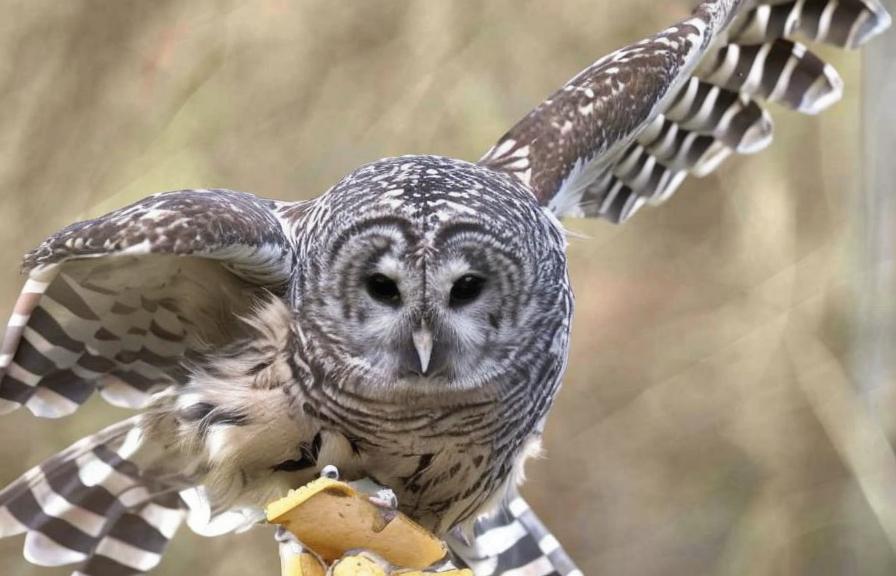
Working with local wildlife authorities is essential for addressing concerns related to hawk predation on quail populations. Wildlife authorities can provide valuable expertise and guidance on managing predator-prey interactions and implementing effective conservation strategies. By collaborating with wildlife authorities, landowners can access resources such as technical assistance, funding opportunities, and regulatory support for conservation efforts.
In addition to seeking guidance from wildlife authorities, landowners can also participate in community-based conservation initiatives and engage with local stakeholders to raise awareness about the importance of hawk and quail conservation. By working together with local wildlife authorities and other stakeholders, landowners can contribute to the long-term sustainability of quail populations while promoting responsible stewardship of natural resources.
Educating Others about Hawk and Quail Conservation
Educating others about hawk and quail conservation is crucial for fostering a culture of environmental stewardship and promoting coexistence between wildlife species. Landowners can play a key role in educating their communities about the importance of conserving both hawks and quail, as well as the interconnectedness of predator-prey relationships in natural ecosystems. This can be achieved through outreach activities such as workshops, field days, and educational materials that highlight the value of maintaining healthy wildlife populations.
Furthermore, landowners can engage with schools, youth groups, and other community organizations to raise awareness about hawk and quail conservation. By sharing their knowledge and experiences with others, landowners can inspire future generations to appreciate and protect wildlife habitats. Ultimately, educating others about hawk and quail conservation can help foster a sense of responsibility towards preserving biodiversity and promoting sustainable coexistence between wildlife species.
In conclusion, understanding the behavior of hawks and quail is essential for creating a safe habitat for quail and implementing effective hawk deterrents. By providing shelter and cover for quail, monitoring and managing hawk activity, working with local wildlife authorities, and educating others about hawk and quail conservation, landowners can contribute to the long-term sustainability of quail populations while promoting responsible stewardship of natural resources. Through proactive conservation efforts and collaborative partnerships, it is possible to support healthy ecosystems where hawks and quail can thrive together in balance.
If you’re looking for ways to protect your quail from hawk attacks, you may also be interested in learning about the best coop options for chickens. Check out this informative article on what kind of coop is best for chickens to ensure the safety and well-being of your poultry.
FAQs
What are some methods to keep hawks from killing quail?
Some methods to keep hawks from killing quail include providing cover and hiding spots for the quail, using scare tactics such as noise makers or visual deterrents, and using netting or fencing to protect the quail.
What type of cover and hiding spots can be provided for quail?
Quail can be provided with cover and hiding spots by planting dense shrubs and bushes, creating brush piles, and providing tall grasses and other vegetation for the quail to hide in.
What are some scare tactics that can be used to deter hawks from attacking quail?
Scare tactics that can be used to deter hawks from attacking quail include using noise makers such as air horns or whistles, hanging shiny objects such as CDs or aluminum foil strips, and using predator decoys such as fake owls or hawks.
How can netting or fencing be used to protect quail from hawks?
Netting or fencing can be used to protect quail from hawks by creating a physical barrier that prevents the hawks from accessing the quail. This can be done by covering the quail’s enclosure with netting or by installing a fence around the perimeter of the quail’s habitat.
Meet Walter, the feathered-friend fanatic of Florida! Nestled in the sunshine state, Walter struts through life with his feathered companions, clucking his way to happiness. With a coop that’s fancier than a five-star hotel, he’s the Don Juan of the chicken world. When he’s not teaching his hens to do the cha-cha, you’ll find him in a heated debate with his prized rooster, Sir Clucks-a-Lot. Walter’s poultry passion is no yolk; he’s the sunny-side-up guy you never knew you needed in your flock of friends!

